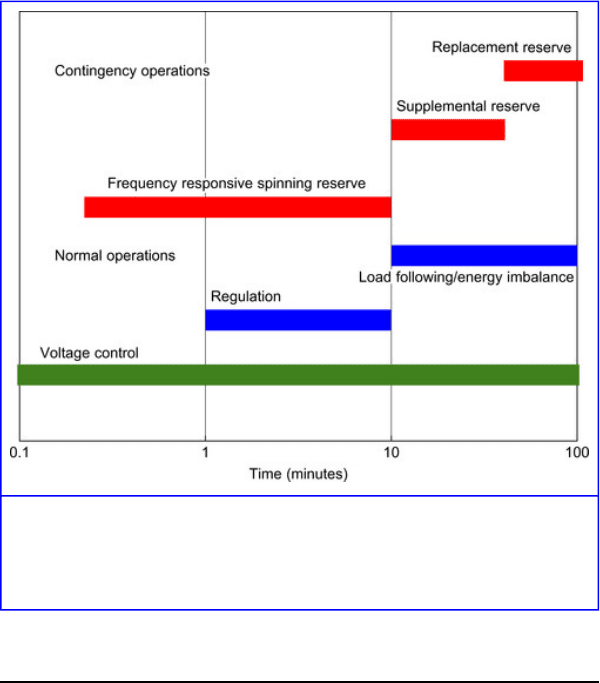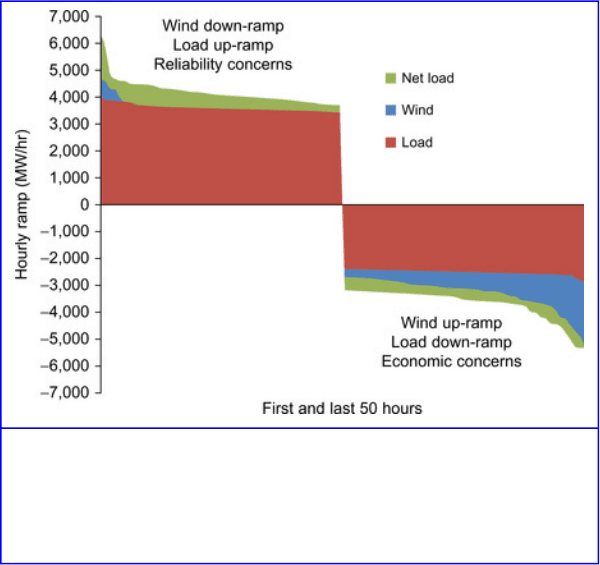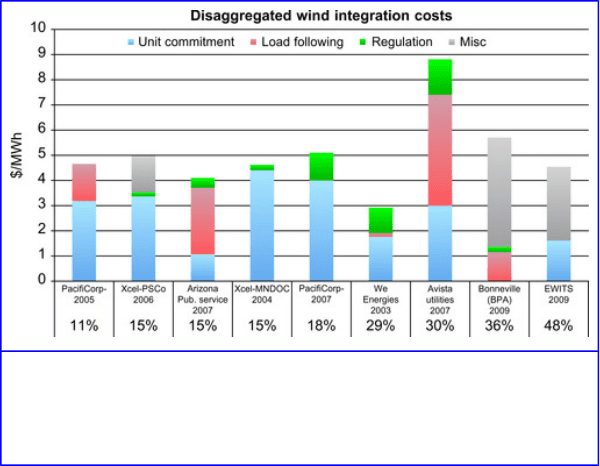Sioshansi F.P. Smart Grid: Integrating Renewable, Distributed & Efficient Energy
Подождите немного. Документ загружается.

years, growing from 0.7% in 2006 to 4.7% in 2008 [11]. The
American Reinvestment and Recovery Act provided $3.4
billion for AMI manufacturing, implementation, and
innovation.
1
Bloomberg New Energy Finance projects that
58 million homes in the United States will be equipped with
smart meters by 2014, with 50 million homes equipped by
2012. Whether AMI rollout will simply enable faster data
collection or facilitate vast DLC distribution is yet to be
determined.
1
DOE (2009). October Press Release. http://energy.gov/news/8216.htm.
In addition, Order 745 (RM10-17) issued by the Federal
Energy Regulatory Commission in March 2011 will allow
regional transmission organizations and independent system
operators to pay DR resources the full market price for energy
under certain conditions. This increased compensation for
demand-side resources, if widely implemented in the
organized markets, could fuel increased growth in DR,
beyond the levels previously contemplated.
Future Pareto improvements will occur when the externalities
of climate change are properly incorporated into the macro
economic analysis. When the goal of minimizing consumer
costs is better informed through valuation of environmental
externalities DR's function will transition from a role limited
to peak demand reduction to cover a broader gamut of
applications including VER firming.
Variable generation increases the need for ancillary services
that DR can provide, and this will open the door to continued
smart grid deployment—as the key enabler of the grid's
decarbonization. Recent studies have shown that supporting
461
enhanced penetrations of wind and solar generation is among
the greatest potential reductions in carbon emissions
attributable to smart grid technology [1], [2] and [12]. The use
of DR for these applications will bring about a dramatic
change in the frequency of DR utilization. Currently DR
programs are called upon a handful of times a year during
extreme events. Under a DR-VER-firming paradigm, DR
would be utilized more frequently in normal grid operations,
as opposed to contingency operations, but for very short
durations to avoid sacrificing the original intent of the energy
service.
Ancillary Services
Ancillary service markets in the electricity sector are
paramount to grid reliability and minimizing the
consequences of capricious power generation. In order to
maintain voltage and frequency stability on the system, grid
operators call upon units to provide standby increases or
reductions in supply. These standby services, known as
ancillary services, were established after deregulation as a
means toward valuation of the services that vertically
integrated utilities traditional deployed in-house to maintain
the grid's stability.
Ancillary service markets are categorized based on the
timescale of the response to a request. Figure 9.5 illustrates
the temporal and operational topology of existing ancillary
service markets. Spinning reserves, for instance, must be
provided within roughly 10 minutes of the grid operator's
request. Regulation services, in comparison, are intended for
minute-to-minute fine-tuning of the grid frequency. Typically
these services are the most difficult for conventional
generators to provide, and typically command the highest
462

price. In the absence of ancillary services, a violation of the
grids narrow frequency thresholds (+ or – 1%) will result in
cascading failure, as synchronous generators disconnect to
protect their systems [13].
Figure 9.5
Temporal and operational classifications in the ancillary service topology.
Source: Kirby [38]
Regulation Services
Both regulation and load-following services are utilized on a
daily basis as part of the grid's normal operations. Generators
providing regulation typically incur costs for efficiency loss
463
due to throttling and ramping, environmental costs due to
increased emissions, increased O&M costs due to equipment
wear and tear, and lost opportunity costs in the energy market
[14]. Consequently, a price premium is placed on regulation
services based on these costs and the difficulty of closely
following regulation requests with conventional thermal units
[15].
Historically, regulation markets have not reflected differences
in speed or accuracy of delivery. This is indeed changing as
new ancillary service market products have appeared in
ISO-NE that pay premiums for fast-acting regulation services.
These “mileage-payment” market products are also under
review in CAISO and PJM [37]. In Chapter 6, Sanders et al.
discuss the management of system frequency in the context of
the California market.
Procuring higher quality regulation control may reduce the
system's regulation requirements and reduce the cost of
regulation services. A regulation market structure that
discerns the quality of regulation services will augment the
grid's reliability and support the development of alternative
regulation providers. Dispatchable loads are able to provide
high-quality regulation service. The response times of
low-latency smart grid protocols are generally less than 500
ms compared to fossil-fuel generation, which sometimes
requires 1–10 seconds to provide regulation services [16].
Solid-state controls are expected to perfectly follow system
operator regulation commands, making DLC the regulation
provider of choice. Brendan Kirby notes that loads with large
adjustable speed drives, or solid-state power supplies, are
ideal candidates [15]. A body of literature has outlined ways
in which electric vehicles could provide regulation services in
464

strategies collectively referred to as vehicle-to-grid
technology [17], [18] and [19]. Hindsenberger et al. present
an analysis of this approach in the context of New Zealand's
system in Chapter 19. Using loads to provide regulation
services, as opposed to wind turbines, has the added
reliability advantage that the power system will not lose both
its regulation and energy supply resource if the wind dies
down. Also, additional regulation services will be crucial to
the deployment of utility-scale solar PV. There is the
preliminary indication that solar PV presents a greater need
for regulation services than wind energy.
Load Following
Load following and energy imbalance ancillary service
markets are best suited to managing the ramping events
triggered by high-capacity wind integration. Dispatchable DR
can be utilized as a tool for smoothing wind ramping events.
Large-scale wind ramp events, like conventional
contingencies, occur infrequently and also are typically
slower than conventional load ramps [20]. Michael Milligan
emphasizes that the vast majority of wind ramp events
observed in the Eastern Wind Integration and Transmission
Study have ramp rates of less than 4,000 MW/hr, which, in
the context of a footprint-wide load of 300,000 MW, are
relatively easy to accommodate with moderate system
flexibility and sufficient transfer capacity in the transmission
system [3].
The asymmetry of extreme wind and load ramps (Figure 9.6)
illustrates the greater frequency of economically constrained
conditions, as opposed to reliability-constrained conditions.
465
Essentially meteorology and the physical relation of a
turbine's power output being proportional to the wind's
velocity cubed, result in wind up-ramps that are less “peaky”
than turbine down-ramps [20]. Compounding this asymmetry
is the fact that load down-ramps, which occur when people
turn things off, are less “peaky” than load up-ramps. In other
words, people come home and turn things on all at the same
time, but turn things off over longer periods of time with a
greater degree of randomness. Thus wind turbine operators
are left with a greater likelihood of needing to “spill energy”
(an economic constraint) than procure additional peak
capacity from a battery or natural gas turbine (a reliability
constraint). Loads well suited to profit from spilled energy
during extreme wind up-ramps include water pumping,
irrigation, municipal treatment facilities, thermal storage in
large buildings, industrial electrolysis, aluminum smelting,
electric vehicle charging, and shale oil extraction [20].
Incentivizing these loads to take advantage of excess power
during extreme wind up-ramps parallels market structures that
incentivize industrial loads to turn off during extreme
reliability events.
466

Figure 9.6
First and last 50 hours of a ramp duration curve indicates the asymmetric nature
of wind and load ramps.
Source: Kirby and Milligan [20]
Energy markets are generally able to obtain a great deal of
load-following response from intermediate and peaking
generators without explicitly paying for them [14]. There is
often no premium placed on maneuverability in
load-following ancillary service markets. Adequate incentive
for load-following DR participation will most likely occur
during events that exceed the maximum ramp rate of plants
already in operation during the event. The economics of
peaking plant operation will typically set the price in
load-following markets.
The same market forces that drive reliability resources will
govern load-following DR. Utilizing DR as a resource for
467

extreme wind ramp events is analogous to utilizing DR as a
resource for extreme heat waves. Both events, after all, stem
from high- and low-pressure systems driven by synoptic-scale
Rossby waves. One key difference, however, is that economic
load-following applications will likely demand higher
dispatch frequency than reliability modes typically require.
As discussed below, this will have important implications
both for the economics that drive those applications and the
resources topology necessary to serve them.
Contingency Reserves
Spinning, non-spinning, and supplemental operating reserves
all classify as contingency reserves on different temporal
scales. These resources are called into action for reliability
purposes, typically when a generator unexpectedly shuts
down. Immediate response is required from reserves to
provide frequency and voltage support for a short duration
(minutes for spinning and hours for non-spinning). Milligan
notes that because wind plant outages typically only occur at
the level of individual turbines and because short-duration
fluctuations are averaged out over the array, wind output
typically changes only by small fractions of its nameplate
capacity. By contrast, a conventional generator can trip during
peak load hours and therefore presents greater reliability
constraints than wind and solar [14].
Advanced metering infrastructure and low-latency
communication networks allow certain responsive loads to
respond faster, and at a lower cost, to contingency events than
traditional generators. Quite simply, it is more efficient to
turn loads off for short durations than to leave generators
“spinning” for long durations. Residential and commercial air
468
conditioning, refrigeration, pumping loads, hot water heating
and industrial aluminum smelting all qualify as attractive
spinning reserve loads [15]. These loads are ideal because
their use generally coincides with peak spinning reserve
pricing. Steady revenue streams and minimized disruptions
encourage the use of DLC participation. Spinning reserves are
called up relatively infrequently (every few days), and for
short durations (11 minutes for spin and non-spin) [20]. The
aforementioned loads would be able to collect additional
revenue streams without sacrificing the intent of the original
energy service.
Wind Integration Cost
Wind integration costs are typically defined as those
incremental costs incurred in the operational time frames that
can be attributed to the variability and uncertainty introduced
by wind generation. These integration costs can be minimized
by thoroughly utilizing ancillary services provisioned by
DLC. The increased operational costs, brought onto the bulk
power system, can be temporally disaggregated to include
regulation, load following, and unit commitment. The
integration costs associated with the merit order effect are
sometimes treated separately and sometimes bundled into
unit-commitment costs. Studies find that the cost of
integrating wind rises with greater wind penetrations [5].
DLC DR is capable of decreasing the regulation and
load-following portions of the integration costs. Nine of the
sixteen wind integration studies surveyed by Wiser
disaggregate integration costs by temporal classification [21].
With the caveat that each study represents a different relative
wind capacity, ranging from 11% to 48%, Figure 9.7
469

illustrates the average share of each temporal classification's
integration cost.
Figure 9.7
Wind Integration costs, temporally disaggregated.
Source: Wiser and Bolinger [21]
Unit-commitment integration costs are typically greater than
regulation or load-following integration costs.
Unit-commitment cost-mitigation strategies for wind
integration include, but are not limited to, aggregating wind
plant output over large geographic regions [22], consolidating
balancing authorities [23], increasing the fidelity of wind
forecasting [24] intra-hour wind scheduling [25], making
better use of physically (as opposed to contractually)
available transmission lines, dynamic thermal line rating [26]
and improved unit-commitment algorithms that incorporate
adaptive load management [27]. Economic DR programs that
provide dynamic pricing signals to participants can be utilized
to mitigate the unit-commitment costs of wind integration.
470
